In for a much needed review is the MAG Z790 TOMAHAWK MAX WIFI from MSI. This is a top of the line Intel Z790 chipset motherboard, featuring a price point of ₱21, 760 Pesos or about $299.99 USD directly from Amazon.
The TOMAHAWK MAX holds a significant position into MSI’s Z790 lineup, improving upon the base Tomahawk model’s specifications. That includes Wi-Fi 7, Bluetooth 5.4 and support for DDR5-7800 memory kits.
Disclosure: MSI sent the MAG Z790 TOMAHAWK MAX WIFI for the purpose of this review. They did not ask me to say anything particular about it.
Technical Specifications
| Processor | |
|---|---|
| CPU | Intel Core (12th, 13th, 14th), Pentium Gold, Celeron |
| Chipset | Intel Z790 |
| Socket | Intel LGA 1700 |
| Memory | |
| SDRAM | DDR5 |
| Interface | 4x LO-DIMM |
| Channel | Dual Channel |
| Speed | 7800 MT/s (OC) |
| Capacity | 192 GB (Max) |
| Graphics | |
| GPU | Integrated |
| Multi-GPU | N/A |
| Expansion | |
| PCIe | 2x PCIe x16, PCIe x1 |
| Storage | |
| Interface | 8x SATA, 4x M.2 |
| RAID | 0/1/5/10 |
| Network | |
| Ethernet | Intel 2.5 Gbps |
| Wi-Fi | Wi-Fi 7 |
| Bluetooth | Bluetooth 5.4 |
| Audio | |
| DAC | Realtek ALC4080 |
| ADC | Realtek ALC4080 |
| Amplifier | N/A |
| Channel | 7.1 |
| External | |
| USB | 4x USB 3.2 Gen 1 Type-A, 4x USB 3.2 Gen 2 Type-A, USB 3.2 Gen 2 Type-C, USB 3.2 Gen 2×2 Type-C |
| Ethernet | RJ45 |
| Audio | 5x 3.5mm, S/PDIF |
| Display | DisplayPort, HDMI |
| Internal | |
| USB | 4x USB 2.0, 2x USB 3.2 Gen 1, USB 3.2 Gen 2 |
| Audio | JAUD |
| Fan | CPU Fan, Pump Fan, 6x System Fan |
| LED | 3x JARGB_V2, JRGB |
| Dimensions | |
| Length | 304.8 mm |
| Width | 243.84 mm |
| Height | N/A |
| Weight | 1440 grams |
Packaging and Accessories
MSI packed the Z790 TOMAHAWK MAX WIFI inside a cardboard packaging.
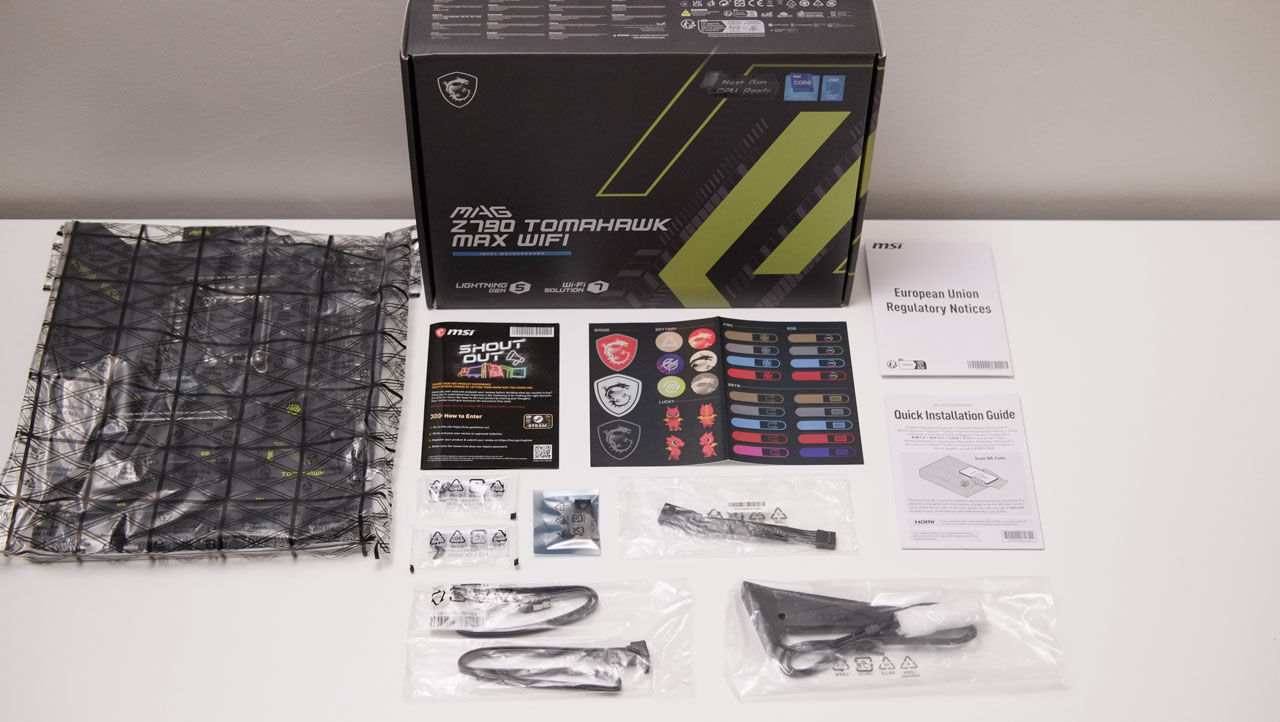
Scope of delivery are as follows:
- MSI MAG Z790 TOMAHAWK MAX WIFI
- 2x SATA cable
- 2x EZ M.2 clip
- USB Drive
- Wi-Fi antenna
- Front panel connector
- Cable sticker
- Documentation(s)
The bundled accessories are more than enough to please most gamers and enthusiasts. I like that we’ve got quality of life stuff here like the tool-free M.2 retention clips, a hassle-free front panel connector and a USB drive complete with software and drivers to get the build started.
Design, Build and Connectivity
The MSI MAG Z790 TOMAHAWK MAX WIFI looks modern in its Black and Lime Green colorway. This is a 1.4 kilogram ATX motherboard so it is also hefty – requiring a bit of TLC when handling.
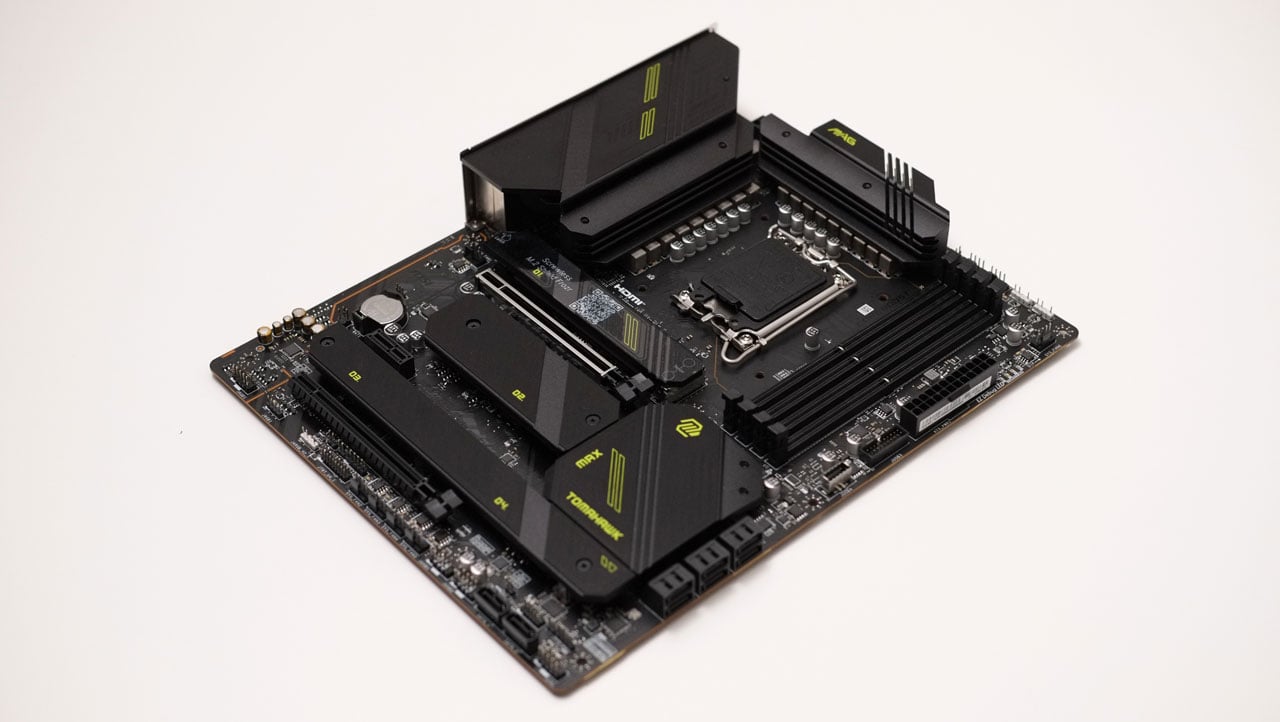
The back showcases MSI’s quality control, featuring perfectly soldered joints. Surface mounted parts are also highlighted in this area. That includes the DDR5 slots and the PCIe 5.0 x16 expansion slot. Sadly, the secondary full-size PCIe slot (4.0 x4) is electrically limited to x4 speeds.
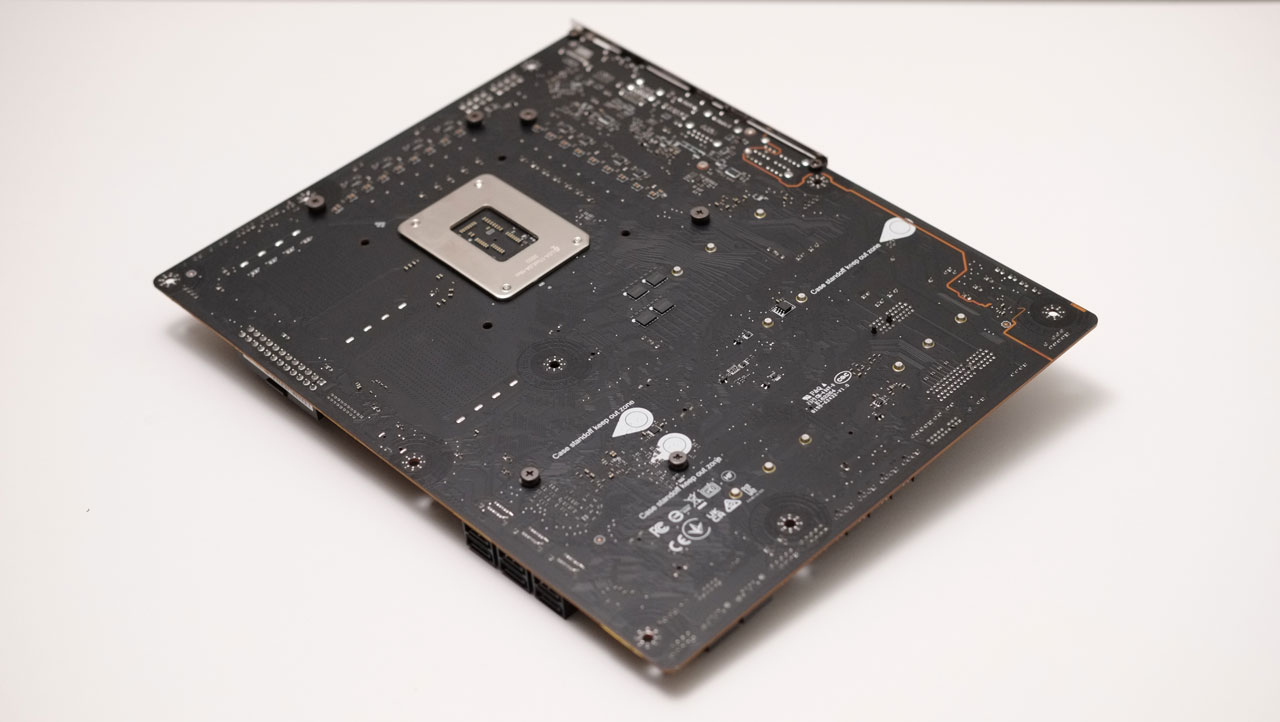
The 16-phase VRM is passively cooled by a chunky pair of CNC’d heatsink. This area also houses the dual 8 + 8-pin CPU power connectors, fan connectors and the RGB lighting connectors.
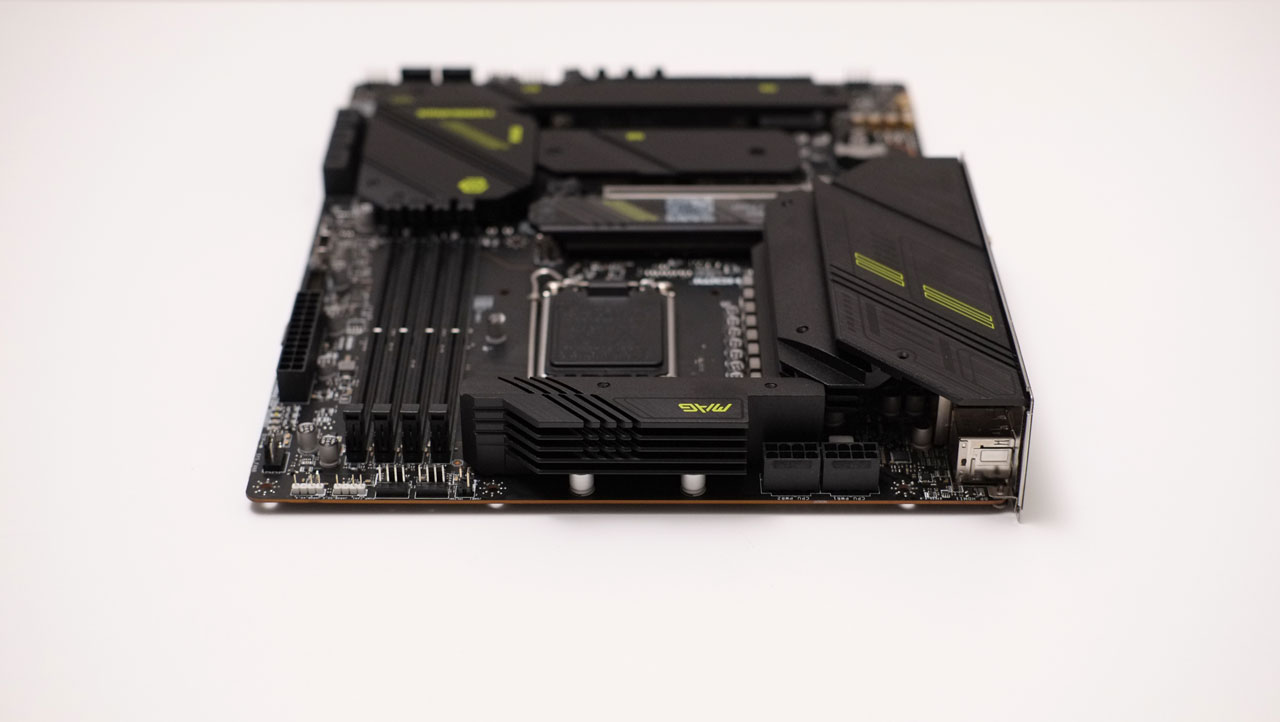
Down below, you’d be delighted to see more auxiliary fan connectors along with the usual stuff – i.e., USB, front panel and audio headers.
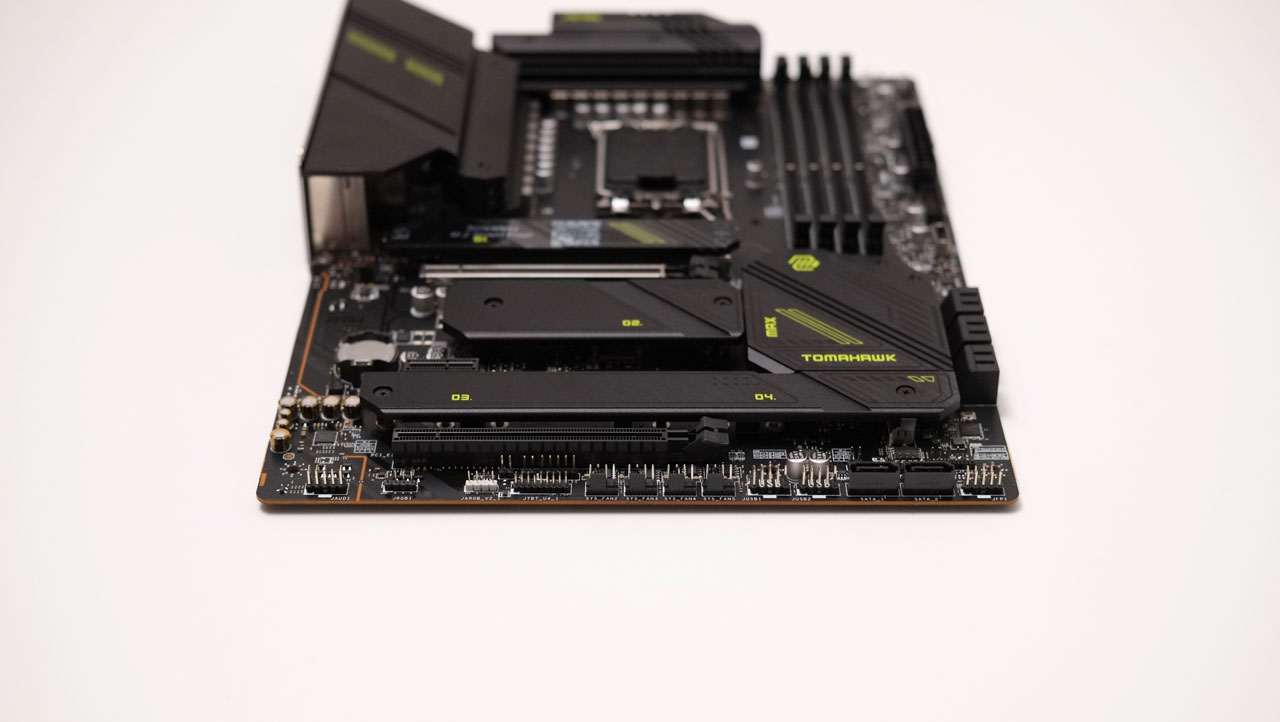
The Z790 TOMAHAWK MAX WIFI sports eight SATA ports and three M.2 slots. Only the top M.2 slot supports PCIe 5.0 (x4) but all of them comes with a passive heatsink.
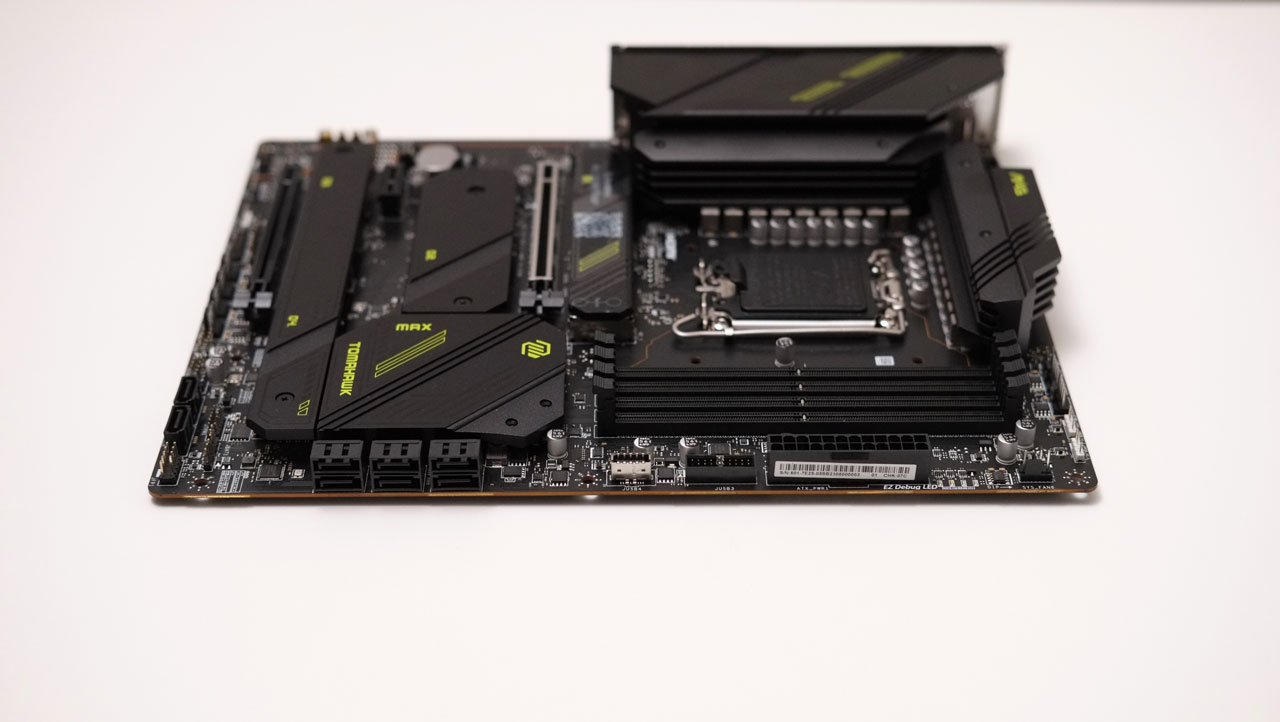
Now the back panel comes with an integrated I/O shield and is almost full to the brim with ports. We’ve got the usual suspects here along with a Clear CMOS and Flash BIOS buttons. I am surprised it doesn’t have USB 4.0 ports though. That’s the only thing worth complaining personally speaking.
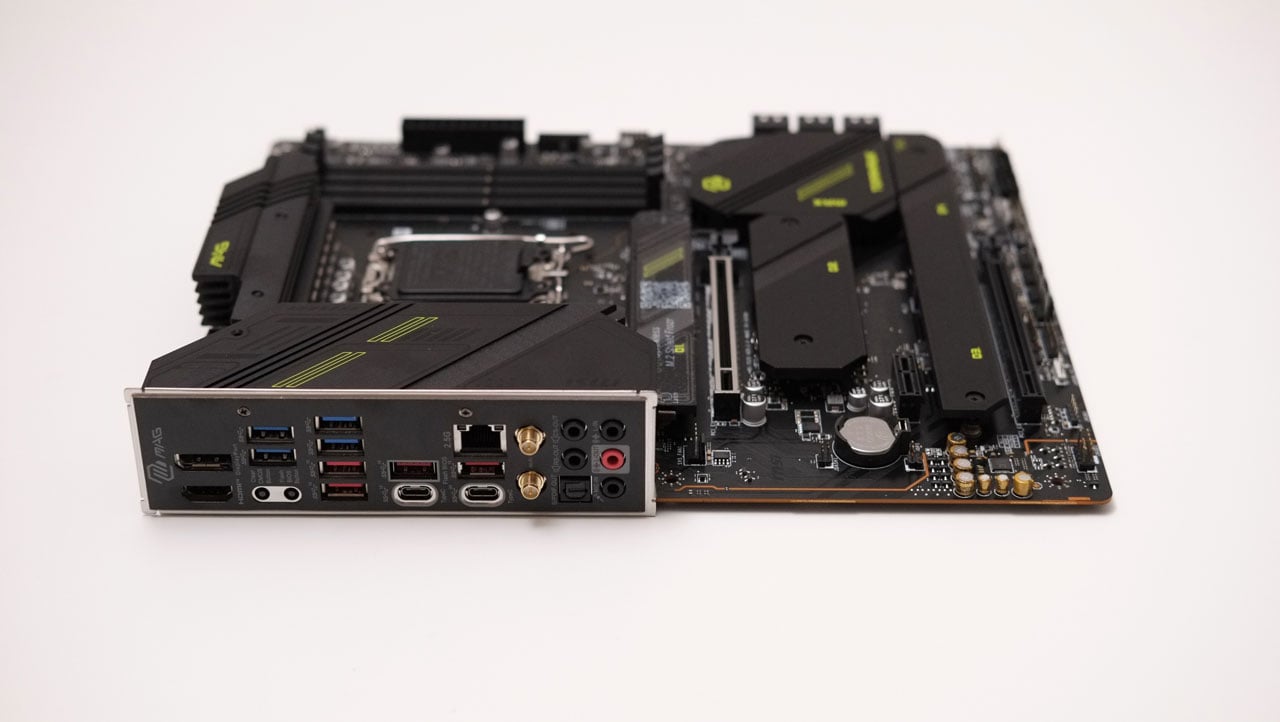
Firmware Interface
MSI’s BIOS or rather its UEFI is easy enough to get around. By default, you will be greeted by an EZ Mode which is fine for the basic stuff.
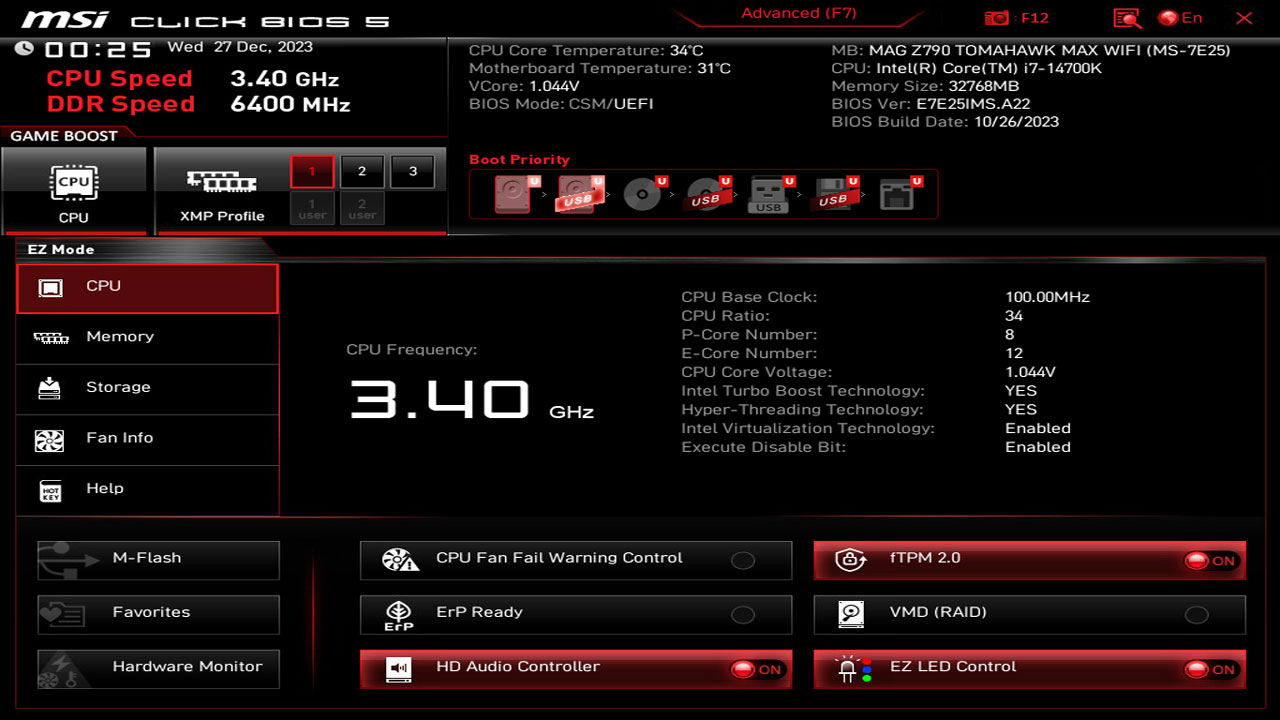
Pressing F7 allows you to switch back and forth from the EZ Mode to Advanced. This one looks more familiar compared to the EZ Mode as it has been the UI of most MSI motherboards for years.
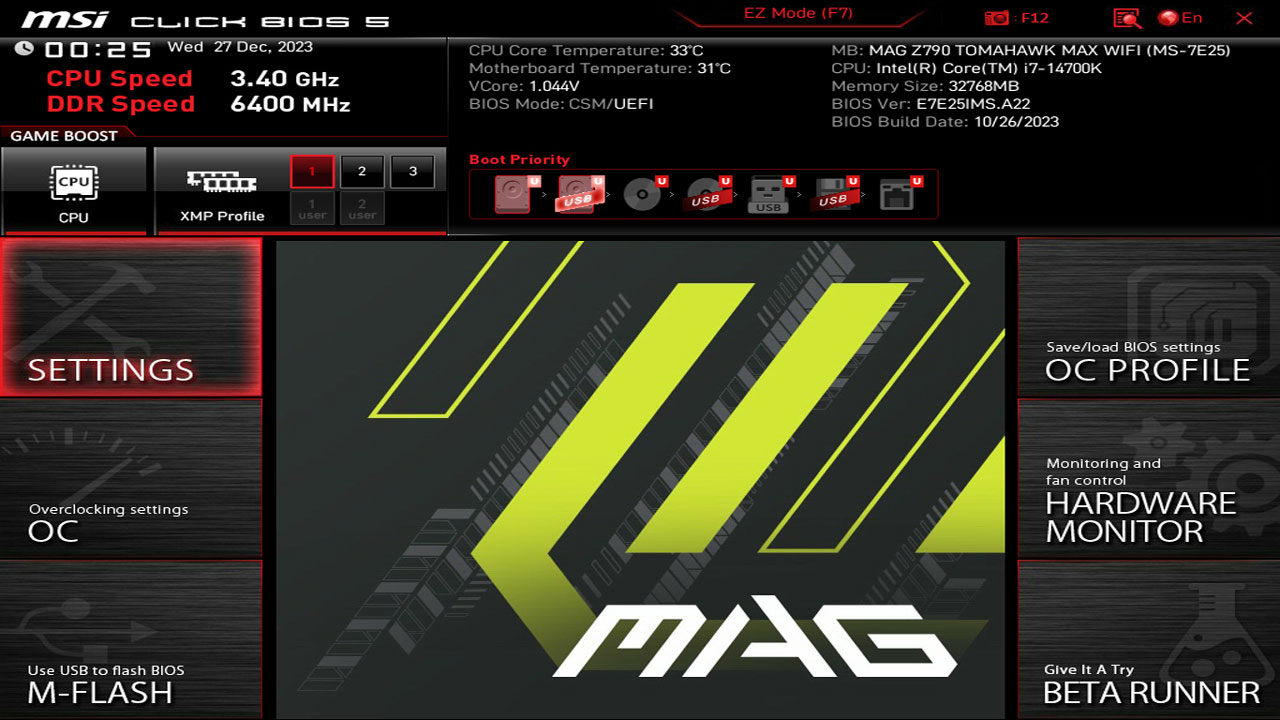
OC settings are comprehensive and I expected no less from MSI’s higher-end offerings.
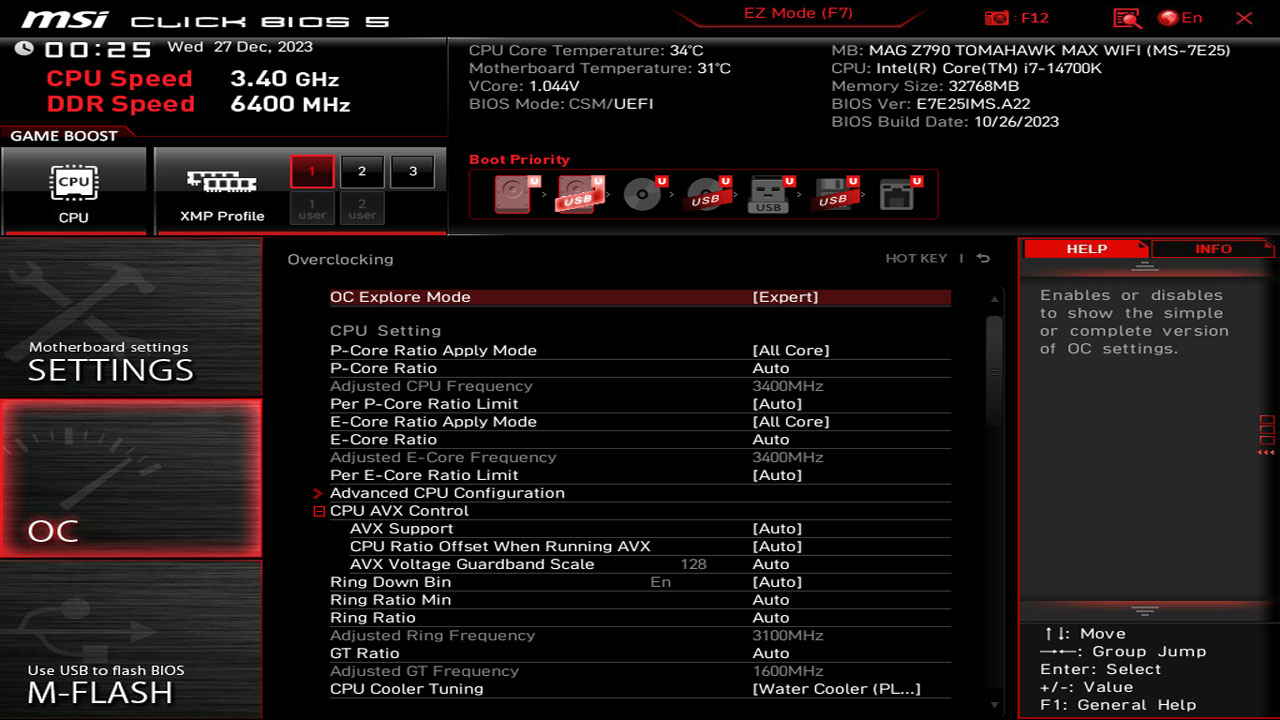
The UEFI Hardware Monitor returns in a familiar yet more detailed format. Its good to see MSI keeping up with times for the said feature.
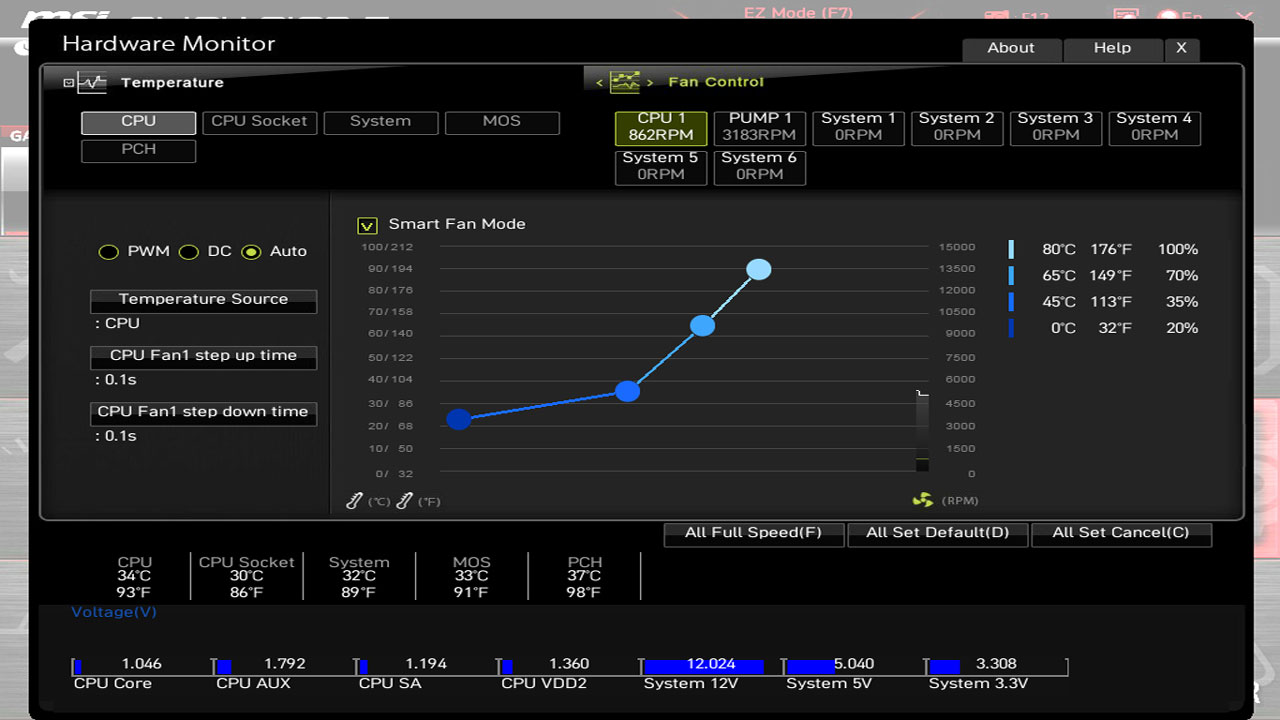
Processor
No issues here. Every score aligns with the usual results I’ve seen with other systems running the Intel Core i7-14700K.
Memory
Pretty much spot-on memory performance here with 6000+ MT/s memory kits.
Graphics
Performance is in-line with other Radeon RX 6700 XT results I’ve seen. That said, this motherboard shouldn’t impede the performance of the said card.
Storage
Using the PCIe 5.0 slot for our PCIe 4.0 x4 drive worked exactly the opposite performance-wise – although not that much compared to our PCIe 4.0 test run.
USB storage performance is pretty good. Got nothing to complain here really.
Network
MSI had the TOMAHAWK MAX equipped with Intel’s 2.5 Gbps LAN. Speed is what I could say just as expected considering my limitations, reaching a peak of 2276 Mbps.
The board supports Wi-Fi 7 but I have no way to test it – again, considering my limitations. That said, we still could test its 5 GHz band performance. The unit peaked at 560 Mbps but its transmission speed could do better.
Audio
MSI used Realtek’s ALC4080 for the TOMAHAWK MAX WIFI. This is a mid to high-end audio solution, featuring support for 7.1 surround, a signal to noise ratio of 120 dB and support for high bitrate PCM playback/recording. The chip also supports impedance sensing and could actually work with 300 Ω headphones such as the Sennheiser HD600. I have nothing against it but MSI’s design appears to show crosstalk between its left and right channel. THD + N for the line-out is also mediocre but I could accept this kind of performance considering what it brought to the table.
| Right Mark Audio Analyzer | Audio | ||
|---|---|---|
| Test Options | Line-In | Line-Out |
| Noise Level (dBA) | -78.1 | -90.0 |
| Dynamic Range (dBA) | 78.1 | 90.6 |
| THD (%) | 0.017 | 0.046 |
| THD + Noise (dBA) | -65.1 | -63.9 |
| IMD + Noise (%) | 0.092 | 0.061 |
| Stereo Crosstalk (dB) | -0.5 | -0.4 |
| IMD at 10 kHz (%) | 0.041 | 0.076 |
Temperature
With a chunky cooler, the effective temperature of the VRM never went past 64 °C. That might sound hot to some but it is actually cool enough in relation to the component’s thermal properties.
PCH thermal performance has been tested too and we did not find any abnormalities.
Power
Power figures below are the Delta for the TOMAHAWK MAX combined with some components that we do not have the ability to measure. That includes the SSD, the cooler, mouse and keyboard. Regardless, I was surprised to see how much power the motherboard could draw with the CPU already excluded into the mix. I do not have enough sample size here to confirm my findings so use this as a reference for now.
Final Thoughts
The MSI MAG Z790 TOMAHAWK MAX WIFI proves to be a formidable addition to MSI’s Z790 lineup, showcasing a top-tier Intel Z790 chipset motherboard with a price point of ₱21,760 Pesos. Building upon the foundation of the base TOMAHAWK model, the MAX version introduces notable enhancements, including Wi-Fi 7, Bluetooth 5.4, and support for DDR5-7800 memory kits.
The motherboard’s design and build quality are commendable, presenting a modern aesthetic in Black and Lime Green. Weighing 1.4 kilograms, it exudes a robust feel or rather, the heft of something that belongs at its price point. The attention to quality is evident on the back, with flawless soldered joints and well-placed surface-mounted parts, including its DDR5 slots and the PCIe 5.0 x16 expansion slot. The 16-phase VRM and PCH, passively cooled by substantial CNC’d heatsinks, appears to ensure effective thermal management.
Connectivity is addressed with eight SATA ports, three M.2 slots (with passive heatsinks), and a feature-rich back panel boasting an integrated I/O shield and current generation ports. However, the absence of USB 4.0 may be a minor drawback for some users wanting to future-proof.
Performance-wise, the MSI MAG Z790 TOMAHAWK MAX WIFI, paired with the MAG Core Liquid E360 cooler, allowed the Intel Core i7-14700K to remain stable at 5.4 GHz minimum – full load. That said, CPU, memory, GPU performance, storage capabilities, and USB storage performance all met my expectations so I have nothing more to comment concerning those areas.
Network features include Intel’s 2.5 Gbps LAN, delivering speeds up to 2276 Mbps, and Wi-Fi 7 support (albeit untested in this review). Now the Realtek ALC4080 audio solution provides a satisfactory audio experience, although some concerns about crosstalk and THD + N for the line-out should be noted.
Temperature management is effective, with the VRM temperature peaking at a reasonable 64 °C, with no abnormalities found in the PCH’s thermal performance to seal the deal. Power consumption figures reveal eye-brow raising results, though further confirmation may be needed with a larger sample size.
In summary, the MSI MAG Z790 TOMAHAWK MAX WIFI offers a compelling package for gamers and enthusiasts, combining impressive features, solid performance, and thoughtful design. While it may not be without minor flaws, its overall value and capabilities make it a worthy consideration for those seeking a quality and performance driven Intel Z790 motherboard.
MSI MAG Z790 TOMAHAWK MAX WIFI $299.99 USD

Product Name: MAG Z790 TOMAHAWK MAX WIFI
Product Description: The MAG series fights alongside gamers in pursuit of honor. With added military-inspired elements in these gaming products, they were reborn as the symbol of sturdiness and durability.
Brand: MSI
Summary
The MAG Z790 TOMAHAWK MAX WIFI is a robust and feature-rich solution in MSI’s Z790 motherboard lineup. It caters well to gamers and enthusiasts, featuring notable enhancements over the standard version, a commendable re-design, and effective thermal management. Despite minor drawbacks such as the absence of USB 4.0, the motherboard’s impressive feature set and rock solid performance are more than enough to make it a compelling choice within its designated price range.